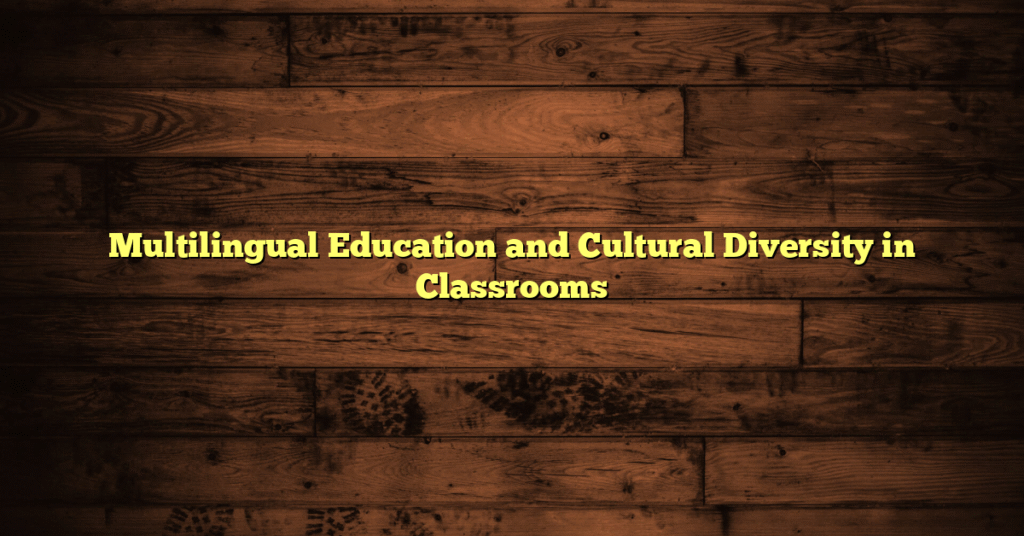In an increasingly interconnected world, the significance of multilingual education cannot be overstated. Multilingual lecture rooms replicate the rich tapestry of cultural fluctuation that school college students carry to universities wherever they’re positioned. These environments do further than merely educate; they cultivate understanding and respect amongst pupils from completely different backgrounds. In this textual content, we’ll uncover the essence of multilingual education, its benefits, challenges, and actionable strategies to address cultural fluctuation contained within the classroom.
Understanding Multilingual Instruction
Multilingual education refers to any form of education that chooses two or further languages, enabling school students to not only evaluate academic content materials and supplies provides nonetheless also develop language skills in pretty just some tongues. This technique is important in instantly’s globalized society, a place where information transcends borders.
The Significance of Language in Instructing
Language is bigger than an instrument for communication; it shapes our thinking, custom-made, and identity. In a multilingual classroom, school college students sometimes evaluate to understand how completely different languages encapsulate distinct worldviews. Educators play a pivotal perform in guaranteeing that school students can uncover these pretty just views, fostering an environment of inclusivity.
Benefits of Multilingual Instruction
Cognitive Advantages
Evaluation has confirmed that bilingual or multilingual school students sometimes exhibit enhanced cognitive expertise. These learners are better at problem-solving, necessary thinking, and ingenious tasks in accordance with a study by the Coronary Heart for Applied Linguistics, multilingual us reveal greater psychological flexibility, which is an asset in academic and day-to-day life.
Cultural Consciousness and Sensitivity
Multilingual education opens doorways to many cultures, promoting empathy and understanding. When students work together with just some languages, moreover, they evaluate in regard to the histories, traditions, and values of the communities these languages signify. This cultural consciousness cultivates respect, reduces prejudices, and enriches social interactions among school-age students.
Tutorial Effectivity
College students who participate in multilingual education ceaselessly perform greater points earlier in language arts. They possess improved learning skills, enhanced vocabulary, and a sturdy grasp of worldwide concepts. A longitudinal look carried out by Stanford College revealed that college students from bilingual backgrounds performed comparably and even better than their monolingual counterparts in standardized tests.
Challenges in Implementing Multilingual Instruction
No matter that it’s fairly just a few benefits, multilingual education faces some challenges. Understanding these may assist educators and policymakers in dealing with systemic elements.
Helpful, useful,, helpful,, useful resource Limitations
Many schools lack access to sufficient resources to implement high-quality multilingual education packages. This consists of licensed lecturers proficient in just some languages and sufficient tutorial offers.
Standardized Testing Constraints
Educators sometimes actually truly feel stress in fulfilling standardized testing requirements, often carried out in a single language. This emphasis may undermine the entire tutorial potential of multilingual school students, forcing educators to limit their instruction to a single language at the expense of a richer, multidimensional curriculum.
Parental Involvement
Parental engagement is important for the success of any tutorial program. In multilingual environments, moms and dads may face challenges as a result of language boundaries, inhibiting their involvement in their children’s education. Faculties ought to uncover inclusive strategies to encourage parental help and participation.
Strategies to Enhance Multilingual Instructing
Adopting good environmental strategies is essential for maximizing some good benefits of multilingual education. Listed beneath are actionable methods to create a culturally rich learning environment:
1. Develop Culturally Responsive Curriculum
Incorporate culturally associated offers into the curriculum. Books, songs, and historical texts that replicate the backgrounds of the students not only promote language skills nonetheless also validate the students’ identities. Integrating storytelling from pretty just some cultures can enhance engagement and understanding.
2. Encourage Collaborative Learning
Group actions that comprise mixed-language collaboration foster peer-to-peer learning. Encourage college students to work collectively on initiatives that require them to profit from their language skills with one another, nurturing a shared learning experience.
3. Reap the advantages of Experience
Leverage know-how to help multilingual education. Language learning choices and online collaboration devices could also be part of college students working with native speakers. Digital exchanges can facilitate real-world conversations and enhance language proficiency.
4. Current Expert Progress for Educators
Put cash into ongoing training for lecturers centered on multilingual education strategies, cultural sensitivity, and equitable practices. Workshops can empower educators with devices and techniques to work collectively with multilingual school students and create inclusive learning environments.
5. Foster College-Neighborhood Partnerships
Work together with native communities to complement the tutorial experience. Partnerships with cultural organizations can include current belongings, purchase of audio systems, or events that take into account fluctuating students’ cultural appreciation and understanding.
Actual-World Examples
Canada’s Bilingual Instruction System
Canada serves as an exemplary model of multilingual education with its dedication to French and English. The nation’s bilingual school strategies not only defend linguistic heritage, nonetheless also create choices for cultural diversity. This security facilitates a further harmonious coexistence amongst its pretty inhabitants.
The Worldwide Baccalaureate (IB) Program
The IB Program emphasizes world citizenship and intercultural understanding. Its curriculum is designed to develop language skills in pretty just some languages, enabling school students to thrive in a multicultural environment. Faculties adopting the IB framework sometimes report improved scholar outcomes in language acquisition and cultural sensitivity.
Actionable Insights
Implementing multilingual education efficiently depends upon collaborative efforts among educators, moms and fathers, and the community at large. Listed beneath are actionable insights for all stakeholders:
-
- Educators: Sometimes mix multilingual strategies into lesson planning. Protect open to selections and repeatedly search for improvement through expert progress.
-
- Mom and father: Work collectively at residence in discussions of spherical cultural heritage and languages. Small initiatives, like learning books in just a few languages to your children, can have a profound impression.
-
- Neighborhood Members: Volunteer your language skills or cultural information in native schools. That’s possibly by the use of mentoring packages or language learning devices that foster inclusive learning experiences.
-
- Policymakers: Advocate for insurance coverage protection, safety insurance coverage protection insurance coverage insurance policies that acknowledge the importance of multilingual education, providing funding and belongings important to help such initiatives.
Conclusion
Multilingual education stands as a beacon of hope in promoting cultural fluctuation inside lecture rooms. Such a method nurtures not solely academic progress, nonetheless also social cohesion and cultural understanding. By collective efforts—be it by the use of group engagement, pedagogical innovation, or security advocacy—educators can kind lecture rooms into vibrant multicultural areas the place where every scholar can thrive.
By prioritizing multilingual education, we aren’t merely instructing languages; we’re advocating for a world the diversity is well-known and harnessed for collective progress. Let’s resolve to foster tutorial environments that embrace linguistic richness and cultural depth, preparing our students for a varied future.



